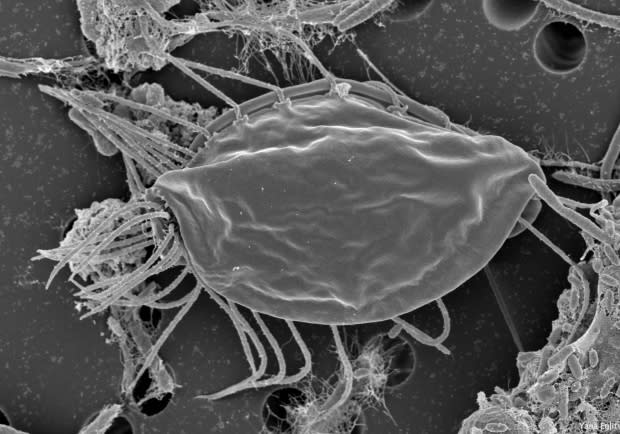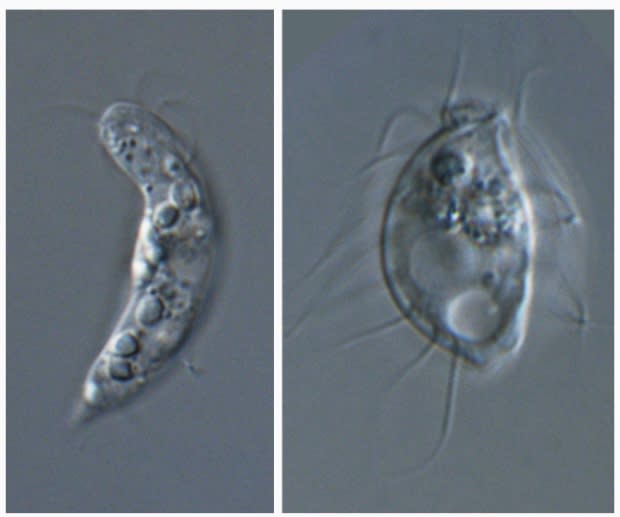Rare microbes lead scientists to discover new branch on the tree of life
Canadian researchers have discovered a new kind of organism that's so different from other living things that it doesn't fit into the plant kingdom, the animal kingdom, or any other kingdom used to classify known organisms.
Two species of the microscopic organisms, called hemimastigotes, were found in dirt collected on a whim during a hike in Nova Scotia by Dalhousie University graduate student Yana Eglit.
A genetic analysis shows they're more different from other organisms than animals and fungi (which are in different kingdoms) are from each other, representing a completely new part of the tree of life, Eglit and her colleagues report this week in the journal Nature.
"They represent a major branch… that we didn't know we were missing," said Dalhousie biology professor Alastair Simpson, Eglit's supervisor and co-author of the new study.
"There's nothing we know that's closely related to them."
In fact, he estimates you'd have to go back a billion years — about 500 million years before the first animals arose — before you could find a common ancestor of hemimastigotes and any other known living things.

The hemimastigotes analyzed by the Dalhousie team were found by Eglit during a spring hike with some other students along the Bluff Wilderness Trail outside Halifax a couple of years ago. She often has empty sample vials in her pockets or bags, and scooped a few tablespoons of dirt into one of them from the side of the trail.
Back at the lab, she soaked the soil in water, which often revives microbes that have gone dormant, waiting for the next big rainstorm. Over the next few weeks, she checked on the dish through a microscope to see what might be swimming around.
Strange movements
Then, one day, about three weeks later, she saw something that caught her eye — something shaped like the partially opened shell of a pistachio. It had lots of hairs, called flagella, sticking out. Most known microbes with lots of flagella move them in co-ordinated waves, but not this one, which waved them in a more random fashion.
"It's as if these cells never really learned that they have many flagella," Eglit said with a laugh. She had seen something with that strange motion once before, a few years ago, and recognized it as a rare hemimastigote.
Hemimastigotes were first seen and described in the 19th century. But at that time, no one could figure out how they fit into the evolutionary tree of life. Consequently, they've been "a tantalizing mystery" to microbiologists for quite a long time, Eglit said.

Like animals, plants, fungi and ameobas — but unlike bacteria — hemimastigotes have complex cells that have mini-organs called organelles including a nucleus that holds chromosomes of DNA, making them part of the "domain" of organisms called eukaryotes rather than bacteria or archaea.
About 10 species of hemimastigotes have been described over more than 100 years. But up until now, no one had been able to do a genetic analysis to see how they were related to other living things.
Realizing that she had something very rare and special, Eglit flagged another graduate student Gordon Lax, who specializes in genetic analyses of individual microbes — a new and tricky technique — to see where they fit in the evolutionary tree. The pair dropped everything to analyze the new microbe.

New species
Eglit wanted to see if she could find more of the creatures in the dish, and, as she was looking, she spotted another kind of hemimastigote.
"To our tremendous surprise, two of these extremely rarely seen organisms ended up in one dish."
There were more of the second kind, which turned out to be a new species.
The researchers named it Hemimastix kukwesjijk after Kukwes, a greedy, hairy ogre from the mythology of the local Mi'kmaq people. (The suffix "jijk" means "little.")
Eglit watched carefully as it hunted. Hemimastix shoots little harpoons called extrusomes to attack prey such as Spumella, a relative of aquatic microbes called diatoms. It grasps its prey by curling its flagella around it, bringing it to a "mouth" on one end of the cell called a capitulum "as it presumably sucks its cytoplasm out," Eglit said.

Once she knew what it ate, she reared its prey in captivity so she could also feed and breed captive Hemimastix: "We were able to domesticate it, in a way."
That means scientists can now give captive specimens to other scientists to study, and their rarity is not the issue it was before.
Based on the genetic analysis they've done so far, the Dalhousie team has determined that hemimastigotes are unique and different enough from other organisms to form their own "supra-kingdom" — a grouping so big that animals and fungi, which have their own kingdoms, are considered similar enough to be part of the same supra-kingdom.
They are now doing a more complete genetic analysis of Hemimastix. That's expected to turn up new data that will help scientists piece together the evolutionary history of life on Earth with more detail and more accuracy.
Eglit says it's "extremely exciting" that it's still possible to discover something so different from all known life on Earth.
"It really shows how much more there is out there."
But Simpson noted that discoveries like this one are pretty rare: "It'll be the one time in my lifetime that we find this sort of thing."

